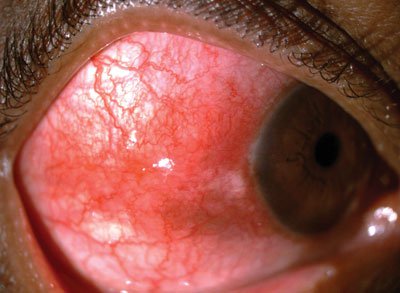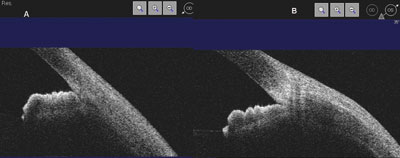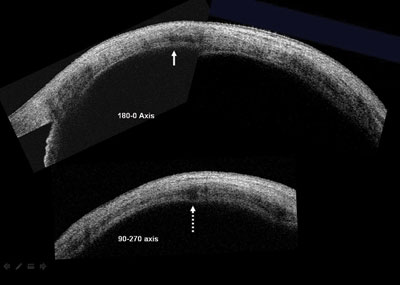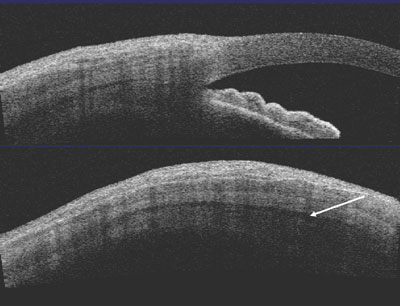Anterior segment OCT used to evaluate cases of nodular scleritis
This non-contact, noninvasive method has several advantages over other imaging modalities.
Nodular scleritis presents with acute nodular elevation of the sclera with inflammation. We used high-speed anterior segment optical coherence tomography of 1310 nm wavelength for evaluation of the scleral disease.
Nodular scleritis
Case 1: A 38-year-old male patient presented with a history of redness and pain in the left eye for 3 months. On slit lamp examination, there was a nodular elevation of the temporal bulbar sclera with surrounding injection of superficial and deep episcleral vessels (Figure 1). Inferior scleral thinning was noted.
Case 2: A 44-year-old male patient presented with a history of pain in the right eye for 1 week. On slit lamp examination, there was a nodular elevation of the temporal bulbar sclera with surrounding injection of superficial and deep episcleral vessels (Figure 2).

Figure 1. Clinical photograph of case 1 showing the nodular scleritis and inferior areas of scleral thinning.
Source: Agarwal A

Figure 2. Clinical photograph of case 2 showing the acute inflammatory nodular scleritis with surrounding congestion of superficial and deep vessels.
Anterior segment OCT
Anterior segment OCT was performed on the patients. Cross-sectional imaging of the eye, centered on the nodular lesion, was taken with high-speed anterior segment OCT (Carl Zeiss Meditec). Corneal high-resolution single scan mode and anterior segment single scan mode were used. Axes 180° to 0°, 90° to 270°, 225° to 45°, and 135° to 315° across the cross section of the nodular lesion were imaged.
In case 1, there was apparent nodular elevation seen from the limbus. There was thickening of the anterior sclera with hyperreflectivity as compared with the sclera of his normal fellow eye (Figure 3). There were few spaces of hyporeflective spots in the deep sclera and focal thinning (Figure 4). In case 2, anterior segment OCT showed marked thickening of the conjunctiva, episclera and sclera over the nodule. There was a prominent elevation noted, starting from the limbus (Figure 5). There was a prominent line or hyporeflective zone longitudinally seen in the scleral surface that is suggestive of the cleavage seen between the scleral lamellae in acute inflammation (Figure 5).

Figure 3. Anterior segment OCT of case 1 showing prominent elevation at the limbus and hyperreflective sclera (b) as compared with the normal fellow eye (a).

Figure 4. Montage image of anterior segment OCT of case 1 showing focal hyporeflective spots (arrows) along the horizontal (above) and vertical axis (below).

Figure 5. Anterior segment OCT of case 2 showing scleral edema (above) and cleavage line in the scleral lamellae (below, arrow).
Discussion
OCT is an optical imaging modality that applies low-coherence interferometry. OCT is the optical analog to ultrasound B-mode imaging except reflections of low-coherence light are detected rather than sound. This is a non-contact and noninvasive imaging method. We have used time-domain high-speed anterior segment OCT with an axial resolution of 18 µm and transverse resolution of 60 µm. This 1310 nm longer wavelength OCT reduces the amount of signal backscattering, which allows better penetration into turbid deep tissue, such as the sclera. Because of its high speed, it minimizes patient motion artifacts and improves the quality of captured images.
In scleritis, the tissue histologically is swollen with displacement of the collagen lamellae by dense clusters of inflammatory cells. In OCT, the tissue edema is seen as the thickening of the involved sclera and the hyperreflectivity is due to tissue infiltration. Focal hyporeflective spots seen in the deep sclera may represent early change due to necrosis. In case 2, in which the patient presented at an earlier stage than case 1, there was more anterior scleral edema. One can also see the prominent line or hyporeflective zone longitudinally in the scleral surface, which is suggestive of the cleavage seen between the scleral lamellae in acute inflammation. These OCT features can be used for monitoring the treatment and explaining the prognosis.
Especially in eyes with acute presentation in which the patient is uncooperative with a contact method such as ultrasound biomicroscopy (UBM), anterior segment OCT may be a valuable tool for evaluation. Although UBM is a proven imaging modality of scleral structures, the higher resolution of OCT (18 µm) as compared with UBM (50 µm) and its noninvasiveness make OCT more patient friendly. Because the OCT examination is a non-contact method, there is no need for local anesthesia or coupling fluid. We believe that high-speed anterior segment OCT can be used as an alternate imaging technique in scleral inflammation.
For more information:
- Amar Agarwal, MS, FRCS, FRCOphth, is director of Dr. Agarwal’s Eye Hospital and Eye Research Centre. Prof. Agarwal is the author of several books published by SLACK Incorporated, publisher of Ocular Surgery News, including Phaco Nightmares: Conquering Cataract Catastrophes, Bimanual Phaco: Mastering the Phakonit/MICS Technique, Dry Eye: A Practical Guide to Ocular Surface Disorders and Stem Cell Surgery and Presbyopia: A Surgical Textbook. He can be reached at 19 Cathedral Road, Chennai 600 086, India; fax: 91-44-28115871; email: dragarwal@vsnl.com; website: www.dragarwal.com.
- Disclosure: The authors have no relevant financial disclosures.
